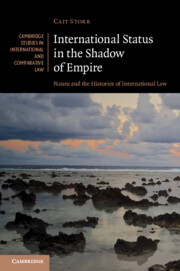Book contents
- International Status in the Shadow of Empire
- Cambridge Studies in International and Comparative Law: 150
- International Status in the Shadow of Empire
- Copyright page
- Contents
- Illustrations
- Acknowledgements
- Prologue
- 1 International Status, Imperial Form: Nauru and the Histories of International Law
- 2 From Trading Post to Protectorate, 1888
- 3 From Protectorate to Colony to Mandate, 1920
- 4 From Mandate to Trust Territory, 1947
- 5 From Trust Territory to Sovereign State, 1968
- 6 After Independence: Sovereign Status and the Republic of Nauru
- Bibliography
- Index
- Cambridge Studies in International and Comparative Law
5 - From Trust Territory to Sovereign State, 1968
Published online by Cambridge University Press: 20 August 2020
- International Status in the Shadow of Empire
- Cambridge Studies in International and Comparative Law: 150
- International Status in the Shadow of Empire
- Copyright page
- Contents
- Illustrations
- Acknowledgements
- Prologue
- 1 International Status, Imperial Form: Nauru and the Histories of International Law
- 2 From Trading Post to Protectorate, 1888
- 3 From Protectorate to Colony to Mandate, 1920
- 4 From Mandate to Trust Territory, 1947
- 5 From Trust Territory to Sovereign State, 1968
- 6 After Independence: Sovereign Status and the Republic of Nauru
- Bibliography
- Index
- Cambridge Studies in International and Comparative Law
Summary
Chapter 5 traces the final shift in Nauru’s status from trust territory to sovereign state in 1968. The dissolution of C Mandate status and the expanded trusteeship system placed Australia and South Africa out of step with global decolonisation movements. Their attempts to maintain control over Nauru and South West Africa attracted international criticism. The chapter examines the relationship between the South West Africa Cases and the UN’s embrace of Nauruan independence. Over the 1960s, the Trusteeship Council brokered independence negotiations between Australia and the Nauru Local Government Council. Australia gradually ceded political control and phosphate ownership but refused liability for the island’s rehabilitation. Nauru’s transition from trust territory to state was a profound achievement, but international recognition of Nauruan sovereignty was deeply ironic. The Republic was regarded less as a viable state than as a vehicle through which the Nauruan people could decide for themselves how to respond to the island’s environmental devastation. The chapter concludes that the 1968 Constitution marked a further accretion of an imperial form of established in the 1880s.
- Type
- Chapter
- Information
- International Status in the Shadow of EmpireNauru and the Histories of International Law, pp. 204 - 243Publisher: Cambridge University PressPrint publication year: 2020



